It is estimated that over 90% of Americans have herpes. More than 40,000 new cases of herpes are diagnosed each day in America alone, that is over 15,000,000 new herpes infections per year! The number of people infected with herpes has reached epidemic proportions. The herpes family of viruses includes 8 different viruses that affect human beings. The viruses are known by numbers as human herpes virus 1 through 8 (HHV1 - HHV8).
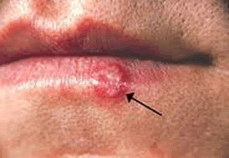
Human herpes virus 1 (HHV1) is also known as herpes simplex virus 1 (HSV1). It is typically the cause of cold sores around the mouth. HHV1 can also lead to infection in the genital area causing genital herpes usually through oral-genital contact, such as after oral sex. HHV1 infections are contagious and are usually spread from skin-to-skin contact with an infected person through small breaks in the skin or mucous membrane. The HHV1 virus is more likely to be spread through things like sharing eating utensils, razors, and towels from a person who has an active lesion.
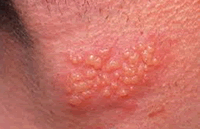
Human herpes virus 2 (HHV2) is also called herpes simplex virus 2 (HSV2). It typically causes genital herpes, a sexually transmitted infection. However, it can also cause cold sores in the facial area. Similar to HHV1, the HHV2 infection is contagious and is spread by skin-to-skin contact. The main route of transmission is through sexual contact, as the virus does not survive very long outside the body.
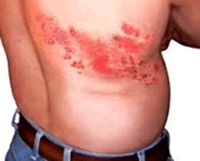
Human herpes virus 3 (HHV3) is also called varicella-zoster virus and causes chickenpox. HHV3 can also cause a recurrent virus infection of the skin, which is called herpes zoster or shingles. Shingles occurs when dormant varicella-zoster virus from an initial bout of chickenpox becomes reactivated. The lesions generally appear in a band-like or belt-like pattern occurring on one side of the body and are often accompanied by itching, tingling, or even severe pain. Healing usually occurs in 2 to 4 weeks, but the scars may remain. Postherpetic neuralgia is a complication of shingles where the pain associated with the infection can persist for months and even years. Most people who experience shingles once do not experience it again.

Human herpes virus 4 (HHV4) is also known as the Epstein-Barr virus. It is the major cause of infectious mononucleosis, or "mono" - the "kissing disease." It is a contagious infection and is transmitted through saliva. Coughing, sneezing, or sharing eating utensils with an infected person can pass the virus from one person to another. About half of all five-year-old children and 90 to 95 percent of adults have evidence of previous infection. It is associated with particular forms of cancer, like Hodgin's lymphoma, especially in those with compromised immune systems. There is evidence that infection with the virus is associated with certain autoimmune diseases, especially dermatomyositis, systemic lupus erythematosus, rheumatoid arthritis, Sjögren's syndrome, and multiple sclerosis.
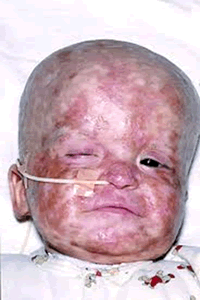
Human herpes virus 5 (HHV5) is the official name of cytomegalovirus (CMV) and is the cause of mononucleosis. In people with healthy immune systems, the virus may not cause any symptoms. It can be sexually transmitted, can cause problems to newborns, and can cause hepatitis. CMV can be transmitted through sexual contact, breast-feeding, blood transfusions, and organ transplants. CMV infection is one of the most difficult complications of AIDS. Symptoms include diarrhea, severe vision problems including blindness, infections of the stomach and intestines, and even death. For a virus that barely causes a problem in most people with healthy immune systems, it can be incredibly deadly in people with damaged immune systems, such as people with AIDS.

Human herpes virus 6 (HHV6) is a recently observed agent found in the blood cells of a few patients with a variety of diseases. It causes roseola (a viral disease causing high fever and a skin rash in small children) and a variety of other illnesses associated with fever in that age group. This infection accounts for many of the cases of convulsions associated with fever in infancy (febrile seizures).
Human herpes virus 7 (HHV7) is even more recently observed and is closely related to HHV6. Like other human herpes viruses, HHV6 and HHV7 are so common that nearly all humans have been infected at some point, usually early in life. HHV7 can also cause roseola, but it is not clear what other clinical effects that this virus causes.
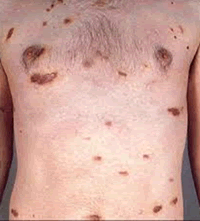
Human herpes virus 8 (HHV8) was recently discovered in certain tumors called Kaposi's Sarcoma (KS). These tumors are found in people with AIDS and are otherwise very rare. KS forms purplish tumors in the skin and other tissues of some people with AIDS. It is very difficult to treat with medication. HHV8 may also cause other cancers, including certain lymphomas (lymph node cancers) associated with AIDS. The fact that these cancers are caused by a virus may explain why they tend to occur in people with AIDS when their immune systems begin to fail. The discovery also provides new hope that specific treatments for these tumors will be developed to target the virus.

 Hepatitis A is caused by eating food and drinking water infected with a virus called HAV. It can also be caused by anal-oral contact during sex. Tens of millions of individuals worldwide are estimated to be infected with Hep A each year. Hepatitis A infection causes no clinical signs and symptoms in over 90% of infected children. Although it can cause swelling and inflammation in the liver, it doesn't generally lead to chronic, or life long, disease. Almost everyone who gets hepatitis A has a full recovery. Early symptoms of hepatitis A infection can be mistaken for influenza, but some sufferers, especially children, exhibit no symptoms at all. Symptoms typically appear 2 to 6 weeks, (the incubation period), after the initial infection. They usually last less than 2 months, although some people can be ill for as long as 6 months. Symptoms include: Fatigue, Fever, Abdominal pain, Nausea, Appetite loss, and Jaundice (a yellowing of the skin or whites of the eyes). Bile is removed from the blood stream and excreted in urine, giving it a dark amber color and likely a Clay-colored feces.
Hepatitis A is caused by eating food and drinking water infected with a virus called HAV. It can also be caused by anal-oral contact during sex. Tens of millions of individuals worldwide are estimated to be infected with Hep A each year. Hepatitis A infection causes no clinical signs and symptoms in over 90% of infected children. Although it can cause swelling and inflammation in the liver, it doesn't generally lead to chronic, or life long, disease. Almost everyone who gets hepatitis A has a full recovery. Early symptoms of hepatitis A infection can be mistaken for influenza, but some sufferers, especially children, exhibit no symptoms at all. Symptoms typically appear 2 to 6 weeks, (the incubation period), after the initial infection. They usually last less than 2 months, although some people can be ill for as long as 6 months. Symptoms include: Fatigue, Fever, Abdominal pain, Nausea, Appetite loss, and Jaundice (a yellowing of the skin or whites of the eyes). Bile is removed from the blood stream and excreted in urine, giving it a dark amber color and likely a Clay-colored feces. Echo (Enteric Cytopathic Human Orphan) viruses are found in the gastrointestinal tract (hence it being part of the enterovirus genus) and exposure to these viruses causes other opportunistic infections and diseases. Echovirus is highly infectious, and its primary target is children. The echovirus is among the leading causes of acute febrile illness in infants and young children, and is the most common cause of aseptic meningitis. Infection of an infant with this virus following birth may cause severe systemic diseases and is associated with high infant mortality rates. The echovirus can mimic symptoms caused by other common bacterial and viral infections.
Echo (Enteric Cytopathic Human Orphan) viruses are found in the gastrointestinal tract (hence it being part of the enterovirus genus) and exposure to these viruses causes other opportunistic infections and diseases. Echovirus is highly infectious, and its primary target is children. The echovirus is among the leading causes of acute febrile illness in infants and young children, and is the most common cause of aseptic meningitis. Infection of an infant with this virus following birth may cause severe systemic diseases and is associated with high infant mortality rates. The echovirus can mimic symptoms caused by other common bacterial and viral infections. Enteroviruses are a genus of viruses associated with several human and mammalian diseases. On the basis of their pathogenesis in humans and animals, the enteroviruses were originally classified into four groups, all of which (along with all serotypes) are included in the Enterovirus Detox Remedy: polioviruses, Coxsackie A viruses (CA), Coxsackie B viruses (CB), and Echoviruses.
Enteroviruses are a genus of viruses associated with several human and mammalian diseases. On the basis of their pathogenesis in humans and animals, the enteroviruses were originally classified into four groups, all of which (along with all serotypes) are included in the Enterovirus Detox Remedy: polioviruses, Coxsackie A viruses (CA), Coxsackie B viruses (CB), and Echoviruses. Dengue fever, also known as breakbone fever, is an infectious tropical disease caused by the dengue virus. Dengue is carried and transmitted by the mosquito. Typically, people infected with dengue virus are asymptomatic (80%) or only have mild symptoms such as an uncomplicated fever. Others have more severe illness (5%), and in a small portion it is life-threatening. The incubation period (time between exposure and onset of symptoms) ranges from 3–14 days with the most common being 4–7 days. Travelers returning from endemic areas are unlikely to have dengue if fever or other symptoms begin more than 14 days after arriving home.
Dengue fever, also known as breakbone fever, is an infectious tropical disease caused by the dengue virus. Dengue is carried and transmitted by the mosquito. Typically, people infected with dengue virus are asymptomatic (80%) or only have mild symptoms such as an uncomplicated fever. Others have more severe illness (5%), and in a small portion it is life-threatening. The incubation period (time between exposure and onset of symptoms) ranges from 3–14 days with the most common being 4–7 days. Travelers returning from endemic areas are unlikely to have dengue if fever or other symptoms begin more than 14 days after arriving home. In some people, the disease proceeds to a critical phase, which follows the resolution of the high fever and typically lasts one to two days. During this phase there may be significant fluid accumulation in the chest and abdominal cavity due to increased capillary permeability and leakage. This leads to depletion of fluid from the circulation and decreased blood supply to vital organs. During this phase, organ dysfunction and severe bleeding, typically from the gastrointestinal tract, may occur. Shock (dengue shock syndrome) and hemorrhage (dengue hemorrhagic fever) occur in less than 5% of all cases of dengue. However, those who have previously been infected with other serotypes of dengue virus ("secondary infection") are at an increased risk.
In some people, the disease proceeds to a critical phase, which follows the resolution of the high fever and typically lasts one to two days. During this phase there may be significant fluid accumulation in the chest and abdominal cavity due to increased capillary permeability and leakage. This leads to depletion of fluid from the circulation and decreased blood supply to vital organs. During this phase, organ dysfunction and severe bleeding, typically from the gastrointestinal tract, may occur. Shock (dengue shock syndrome) and hemorrhage (dengue hemorrhagic fever) occur in less than 5% of all cases of dengue. However, those who have previously been infected with other serotypes of dengue virus ("secondary infection") are at an increased risk. Coxsackieviruses are part of the enterovirus family that thrive in the human digestive tract. They are very contagious and can spread from person to person, usually on unwashed hands and surfaces contaminated by feces, where they can live for several days. In most cases, coxsackieviruses cause mild flu-like symptoms and go away without treatment. Coxsackievirus can produce a wide variety of symptoms. Nearly half of all kids infected with coxsackievirus have no symptoms. Those that have symptoms develop high fever, headache, and muscle aches. Some also develop a sore throat, abdominal discomfort, or nausea. A child with a coxsackievirus infection may simply feel hot but have no other symptoms. In most children, the mild fever lasts about 3 days and then disappears.
Coxsackieviruses are part of the enterovirus family that thrive in the human digestive tract. They are very contagious and can spread from person to person, usually on unwashed hands and surfaces contaminated by feces, where they can live for several days. In most cases, coxsackieviruses cause mild flu-like symptoms and go away without treatment. Coxsackievirus can produce a wide variety of symptoms. Nearly half of all kids infected with coxsackievirus have no symptoms. Those that have symptoms develop high fever, headache, and muscle aches. Some also develop a sore throat, abdominal discomfort, or nausea. A child with a coxsackievirus infection may simply feel hot but have no other symptoms. In most children, the mild fever lasts about 3 days and then disappears. Coronaviruses primarily infect the upper respiratory and gastrointestinal tract of mammals and birds. The most publicized human coronavirus is SARS, which has a unique pathogenesis because it causes both upper and lower respiratory tract infections and can also cause gastroenteritis. Coronaviruses are believed to cause a significant percentage of all common colds in human adults. Transmission is thought to be aerosol, which means person to person transmission through air. It can survive up to 24 hours on metal surfaces, so steam sterilization of an environment should be considered to neutralize the virus.
Coronaviruses primarily infect the upper respiratory and gastrointestinal tract of mammals and birds. The most publicized human coronavirus is SARS, which has a unique pathogenesis because it causes both upper and lower respiratory tract infections and can also cause gastroenteritis. Coronaviruses are believed to cause a significant percentage of all common colds in human adults. Transmission is thought to be aerosol, which means person to person transmission through air. It can survive up to 24 hours on metal surfaces, so steam sterilization of an environment should be considered to neutralize the virus. Bocavirus is a fairly new virus, in terms of discovery. It is generally found in infants and children that are very sick with acute respiratory tract infections. It has been connected to cough, wheezing, fever, cyanosis (bluish or grayish tint to skin due to lack of oxygen), runny nose, diarrhea and vomiting. Research is not conclusive, but it may be linked to more serious respiratory issues like pneumonia and COPD. Some evidence shows that it may even have a link with some cancers like leukemia.
Bocavirus is a fairly new virus, in terms of discovery. It is generally found in infants and children that are very sick with acute respiratory tract infections. It has been connected to cough, wheezing, fever, cyanosis (bluish or grayish tint to skin due to lack of oxygen), runny nose, diarrhea and vomiting. Research is not conclusive, but it may be linked to more serious respiratory issues like pneumonia and COPD. Some evidence shows that it may even have a link with some cancers like leukemia. Astroviruses cause gastroenteritis, predominantly diarrhea, usually in children under five years old although it has been reported in adults. Studies show that more than 80% of children between 5 and 10 years old have antibodies to astroviruses, suggesting they have been exposed to it at some point. Occasional outbreaks in schools, nurseries and families have been reported. However, the number of infections may be under-estimated, since the illness is usually mild, and many cases go unreported. The illness is self-limiting, has a short duration and incidences peak in the winter.
Astroviruses cause gastroenteritis, predominantly diarrhea, usually in children under five years old although it has been reported in adults. Studies show that more than 80% of children between 5 and 10 years old have antibodies to astroviruses, suggesting they have been exposed to it at some point. Occasional outbreaks in schools, nurseries and families have been reported. However, the number of infections may be under-estimated, since the illness is usually mild, and many cases go unreported. The illness is self-limiting, has a short duration and incidences peak in the winter. Adenovirus is a group of viruses responsible for a spectrum of respiratory disease as well as infection of the stomach and intestine (gastroenteritis), eyes (conjunctivitis), bladder (cystitis) and rash. Adenovirus respiratory diseases include a strain of the common cold, pneumonia, croup, and bronchitis. Patients with compromised immune systems are especially susceptible to severe complications of adenovirus infection. Acute respiratory disease (ARD), a disorder first recognized among military recruits during World War II, can be caused by adenovirus infections under conditions of crowds and stress.
Adenovirus is a group of viruses responsible for a spectrum of respiratory disease as well as infection of the stomach and intestine (gastroenteritis), eyes (conjunctivitis), bladder (cystitis) and rash. Adenovirus respiratory diseases include a strain of the common cold, pneumonia, croup, and bronchitis. Patients with compromised immune systems are especially susceptible to severe complications of adenovirus infection. Acute respiratory disease (ARD), a disorder first recognized among military recruits during World War II, can be caused by adenovirus infections under conditions of crowds and stress.